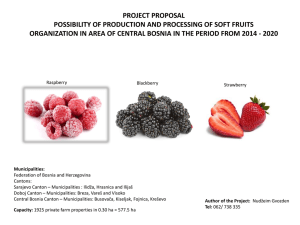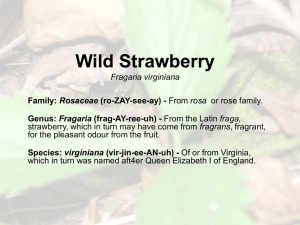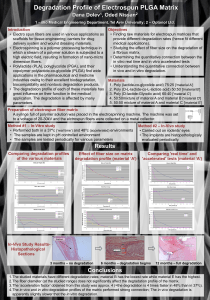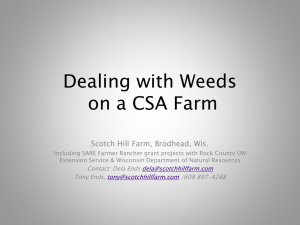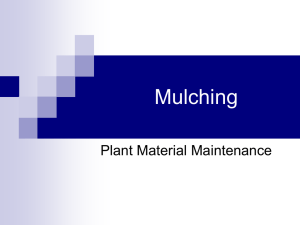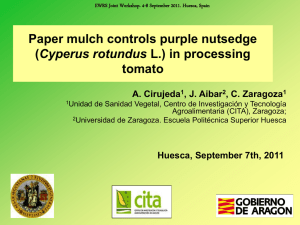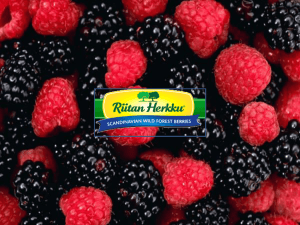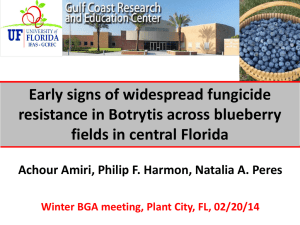Crops WG Progress Report ppt
advertisement
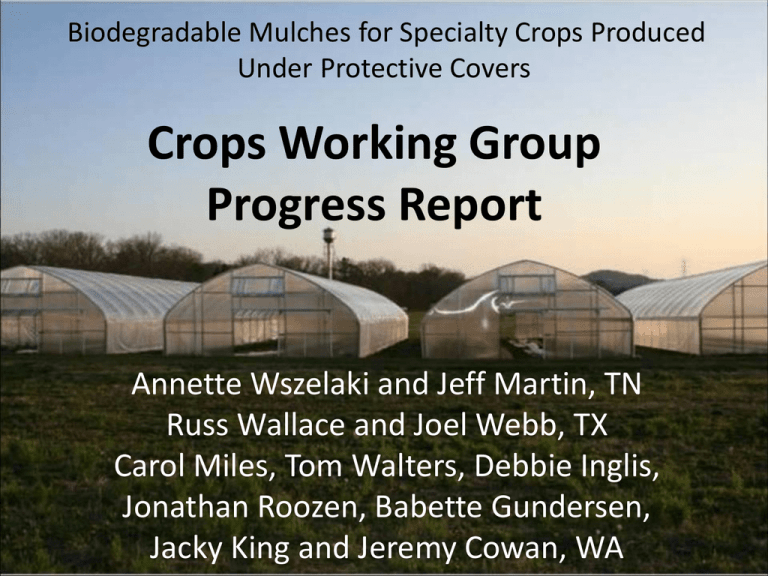
Biodegradable Mulches for Specialty Crops Produced Under Protective Covers Crops Working Group Progress Report Annette Wszelaki and Jeff Martin, TN Russ Wallace and Joel Webb, TX Carol Miles, Tom Walters, Debbie Inglis, Jonathan Roozen, Babette Gundersen, Jacky King and Jeremy Cowan, WA Key objectives: •Evaluate high-value crops commonly used in high tunnel production in relation to productivity, environmental conditions, pest/disease threats, and profitability. •Evaluate tomatoes grown in HT versus open field settings with five BDM treatments and a bareground control. •Study BDMs in greenhouse and field settings in terms of impacts on soil ecology and root health as well as meeting ASTM (and grower) standards for bio-degradability. •Ascertain economic costs and benefits of HT and BDM use. •Identify barriers and bridges to HT and BDM adaptation through focus groups. Wind and blowing dust causes weathering on TX tunnels- making them appear to be years older than they really are! Wind damage to WA tunnels in 2010 Come hail… Hail Damage in Tennessee in April 2011 Crops Working Group Progress Report …or high water! Flooding in Texas in 2010 Lettuce Cultivars 2010 Adriana (Butterhead/Boston) Coastal Star (Romaine) Ermosa (Butterhead/Boston) Greenstar (Greenleaf) Jericho (Romaine) New Redfire (Redleaf) TN Lettuce Results • Both total (number and weight) and marketable yield (weight) differed significantly among varieties and between HT and OF locations. • Total yields were higher in HT, while marketable yields were higher in OF, due to bolting. • Coastal Star had significantly higher marketable yield (by weight) than all other varieties. TX Lettuce Results • Significant V x L interactions were observed for yield and DTH. • Also significant varietal differences for all variables except total plant number. • Within HT, Romaines had significantly higher total plant weight compared to the other four varieties. • In the OF, Jericho, Coastal Star and Green Star had the highest weights. • The number of marketable plants/plot in HT did not differ, while in the OF Butterheads had fewer marketable plants, due to increased bolting. WA Lettuce Results • Lettuce yield was not different due to cultivar or location (HT and OF) except that head height, head diameter and core length were greater in the HT. • Days to harvest were 1 day less in the HT compared to OF, and the earliest maturing cultivar was Green Star (56 DAT) and Jericho and Adriana were the latest (61.25 DAT), but differences were NS. • The relatively cool mild temperatures in NW WA did not induce bolting; however, if temperatures are too cool and rainfall is somewhat high, disease pressure (i.e., Botrytis) and slugs may become an issue. Tip Burn Sclerotinia Tomato Cultivars 2010 Celebrity (Determinate) Cherokee Purple (Indeterminate) Early Girl (Indeterminate) Red Brandywine (Indeterminate) Stupice (Indeterminate) Oregon Spring (Determinate) Red Defender (Determinate) Homestead 24 (Determinate) Strawberry Cultivars Fall 2010 Albion (Everbearing, Bareroot and Plugs) San Andreas (Everbearing, Bareroot) Chandler (June Bearing, Plugs) LCN (June Bearing, Plugs) Strawberry Festival (June Bearing, Plugs) TN Strawberry Results •2010 Spring Planting- temperatures got too hot, too fast •2011 Harvests: •High Tunnels (HT) started March 23… still going. •Open Field (OF) started April 15 and done in by hail on April 27. •Fall planting much better suited to TN climate. •Higher quality and yields of berries in HT. •Hail caused damage both inside and outside; HT plants rebounded, OF did not •Strawberry Festival and Albion (Plugs) top yielders in both HT and OF •Poor pollination, insect damage and leather rot top 3 reasons for unmarketable fruit TX Strawberry Results •Harvests: •High Tunnels (HT) –over 30 harvest (Feb. 21). •Open Field (OF) –15 harvests (Apr. 5) . •Opposite response to spring planting vs. fall planting. •Production: •Higher quality and yields of berries in HT. •OF plots hailed on causing damage to plants. •Increased bird and rodent damage to OF. •Early populations of mites & aphids in HT that needed to be controlled. •Botrytis infected most berries in storage study. WA Strawberry Results •Strawberry total yields were comparable in HT and OF, but marketable yield was greater and culls were less in HTs; culls accounted for 29% of the berries in HTs, and for 46% of the berries in OF; there were fewer overripe and damaged fruit in HTs. •‘Seascape’ produced more marketable berries and more culls than ‘San Andreas’ or ‘Albion’ in both HT and OF. •Type III Bronzing was the most common cause of culled strawberry fruit; catfacing was also common, and in OF ‘Seascape’ had the highest levels; Botrytis and water damage occurred in OF but not HT. Product BioBag AgFilm Company BioBag; Palm Harbor, FL BioTelo Agri Dubois Agrinovation; Waterford, ON, CAN Spunbond nonwoven Saxon, GER; NatureWorks LLC, Blair, NE Black Plastic, Pliant Corp.; 1.0 mil Schaumburg, IL Weed Guard Sunshine Paper Co. Plus LLC; Aurora, CO Non-mulch, bareground control Mulch Content Cornstarch and non-disclosed biopolymers, biodegradable & compostable 100% PLA Standard polyethylene, agricultural plastic control Cellulosic, biodegradable control TN BDM Results • Degradation took place more slowly in HT versus OF. • Spunbond and the traditional black plastic mulches showed very little degradation in both the high tunnel and open field plots. • Both of the cornstarch based mulches (BioBag and BioTelo) showed significant visual degradation in the tunnels and open field by the final evaluation date in August. • The cellulose control degraded similarly to the BioBag in the open field, but degraded more slowly inside the tunnels, likely due to the protection from wind and rain that the tunnels provide. • Weed count was significantly greater in the HT than in the OF at Time 2 but not at Time 3. • The greatest # and weight of weeds were in the Spunbond treatment, while for all other treatments, weed # and weight were significantly less and statistically equivalent. TX BDM Results • Experimental Spunbond material and the polyethylene black plastic did not show signs of degradation (Rips, Tears and Holes (RTH)) either in the HT or OF plots. • Therefore, the spunbond mulch would not likely be considered a good alternative to polyethylene black plastic in terms of decreasing grower’s labor and disposal costs for mulch removal • BioBag, BioTelo and WeedGuard Plus showed significant surface degradation (RTH) by Oct 8, and the average rate was higher in the OF compared to HT environment. • While the numbers of RTH in HT compared to OF plots on Oct 8 were to some degree similar, the associated %SAE was much greater in OF compared to HT plots. • BioBag and BioTelo still required removal by hand both inside the HT and in the OF. • In spring 2011, during land prep, small and large pieces of all the mulches except WeedGuard Plus were found, suggesting that more rapid degradation is needed to eliminate hand removal, especially when used under high tunnel production on the TX High Plains. Pieces of BDMs found in TX plots on May 16 No evidence WeedGuardPlus WA BDM Results • Total # and weight of ‘Celebrity’ tomato fruit were less in bareground and Spunbond than in BioBag and BioTelo treatments. • Tomato fruit cracking was least in the bareground treatment. • M x L interaction for number of tears and visual assessment of degradation; spunbond and black plastic mulch had the least degradation assessed visually in both HT and OF while BioTelo and cellulose control had the most; visual degradation was 2-4 times greater in OF than in HT for all treatments. • Weeds did not differ between HT and OF; weed # and weight were significantly greater in Spunbond mulch than in all other mulch treatments. • In OF, black plastic mulch tended to have less soil moisture than the other treatments; in HT, bareground tended to dry out more rapidly and had more pronounced wet/dry cycles. Hot Topics • Reviewing and/or tweaking protocols for crop harvest and quality assessment (tomato grading in particular), and for weed, disease, insect and environmental monitoring • Plan for manuscripts and writing assignments • Strawberry cultivar selection and procurement • What other sorts of weather events can the tunnels endure?

